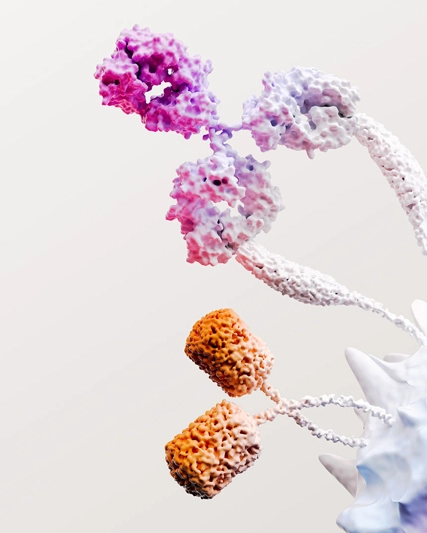Issued: London, UK
For media and investors only
Blenrep (belantamab mafodotin) combinations receive positive CHMP opinion in relapsed/refractory multiple myeloma
- Positive opinion supported by superior efficacy shown in two head-to-head phase III trials, including overall survival in DREAMM-7
- If approved, Blenrep combinations could redefine treatment as early as first relapse where more effective options are needed1,2,3
- Approval decision expected in Q3 2025
GSK plc (LSE/NYSE: GSK) today announced the Committee for Medicinal Products for Human Use (CHMP) of the European Medicines Agency (EMA) has recommended the approval of Blenrep for the treatment of adults with relapsed or refractory multiple myeloma in combination with bortezomib plus dexamethasone (BVd) in patients who have received at least one prior therapy, and in combination with pomalidomide plus dexamethasone (BPd) in patients who have received at least one prior therapy including lenalidomide. An approval decision by the European Commission is expected in the third quarter of 2025.
The CHMP opinion follows the approval of Blenrep combinations by the UK Medicines and Healthcare products Regulatory Agency (MHRA) in April and Japan’s Ministry of Health, Labour and Welfare earlier this month.
Superior efficacy results shown by Blenrep combinations in the pivotal DREAMM-7 and DREAMM-8 phase III trials in relapsed or refractory multiple myeloma support the CHMP opinion. These include statistically significant and clinically meaningful progression-free survival (PFS) results for Blenrep combinations versus standards of care in both trials and overall survival (OS) versus a daratumumab-based triplet in DREAMM-7.2,3,4 The safety and tolerability profiles of the Blenrep combinations were broadly consistent with the known profiles of the individual agents.2,3
Hesham Abdullah, Senior Vice President, Global Head Oncology, R&D, GSK, said: “Today’s positive CHMP opinion is an important milestone toward bringing the benefits of Blenrep combinations to patients with multiple myeloma in Europe. Blenrep is well positioned to address the unmet needs of these patients while also providing the benefit of in-office administration in both academic and community treatment settings without complex pre-administration regimens or hospitalisation.”
There are approximately 50,000 new cases of multiple myeloma diagnosed each year in Europe, and nearly all patients will experience relapse from initial treatment.1,5 Blenrep is the only anti-BCMA (B-cell maturation antigen) antibody-drug conjugate (ADC) agent in multiple myeloma, providing patients at or after first relapse with a differentiated mechanism of action. Blenrep combinations can be administered to a range of patient types in any oncology treatment setting.
DREAMM-7 and DREAMM-8 showed that any eye-related side effects associated with Blenrep can be managed and reversed with appropriate dose modifications and follow-up, allowing patients to maintain benefit and resulting in low rates of discontinuation (≤9%) in both trials.2,3 The most commonly reported non-ocular adverse events (>30% of participants) in the Blenrep combination arm were thrombocytopenia (87%) and diarrhoea (32%) in DREAMM-7, and neutropenia (63%), thrombocytopenia (55%) and COVID-19 (37%) in the Blenrep combination arm of DREAMM-8.
Blenrep combinations are currently under review in all major markets globally, including in the US6 with a Prescription Drug User Fee Act (PDUFA) date of 23 July 2025, China7 (based on the results of DREAMM-7, with Breakthrough Therapy Designation for the combination and priority review for the application), Canada, and Switzerland (with priority review for DREAMM-8).
About multiple myeloma
Multiple myeloma is the third most common blood cancer globally and is generally considered treatable but not curable.8,9 There are approximately more than 180,000 new cases of multiple myeloma diagnosed globally each year.10 Research into new therapies is needed as multiple myeloma commonly becomes refractory to available treatments.1 Many patients with multiple myeloma are treated in a community cancer setting, leaving an urgent need for new, effective therapies with manageable side effects that can be administered outside of an academic centre.11,12
About Blenrep
Blenrep is an ADC comprising a humanised BCMA monoclonal antibody conjugated to the cytotoxic agent auristatin F via a non-cleavable linker. The drug linker technology is licensed from Seagen Inc.; the monoclonal antibody is produced using POTELLIGENT Technology licensed from BioWa Inc., a member of the Kyowa Kirin Group.
Indication
In the UK, Blenrep is indicated in adults for the treatment of multiple myeloma:
• in combination with bortezomib and dexamethasone in patients who have received at least one prior therapy; and
• in combination with pomalidomide and dexamethasone in patients who have received at least one prior therapy including lenalidomide.
IMPORTANT SAFETY INFORMATION FOR BLENREP
More information can be found in the Blenrep Summary of Product Characteristics and Patient Information leaflets available on the MHRA Products website.13
About DREAMM-7
DREAMM-7 is a multicentre, open-label, randomised phase III clinical trial evaluating the efficacy and safety of belantamab mafodotin combined with bortezomib plus dexamethasone (BVd) compared to daratumumab combined with bortezomib plus dexamethasone (DVd) in patients with relapsed or refractory multiple myeloma who previously were treated with at least one prior line of multiple myeloma therapy, with documented disease progression during or after their most recent therapy. The trial enrolled 494 participants who were randomised 1:1 to receive either BVd or DVd. Belantamab mafodotin was administered at a dose of 2.5mg/kg intravenously every three weeks. The primary endpoint was PFS as per an independent review committee, with secondary endpoints including OS, duration of response (DOR), and minimal residual disease (MRD) negativity rate as assessed by next-generation sequencing. Other secondary endpoints include overall response rate (ORR), safety, and patient reported and quality of life outcomes.
In DREAMM-7, BVd nearly tripled median PFS versus DVd (36.6 months versus 13.4 months, respectively (hazard ratio [HR]: 0.41 [95% confidence interval (CI): 0.31-0.53], p-value<0.00001). DREAMM-7 also met the key secondary endpoint of OS, showing a statistically significant and clinically meaningful 42% reduction in the risk of death at a median follow-up of 39.4 months favouring BVd (n=243) versus DVd (n=251) (HR 0.58; 95% CI: 0.43-0.79; p=0.00023). The three-year OS rate was 74% in the BVd arm and 60% in the DVd arm.
PFS results were presented at the American Society of Clinical Oncology (ASCO) Plenary Series in February 2024 and published in the New England Journal of Medicine. OS results were presented at the American Society of Hematology (ASH) Annual Meeting in December 2024.2,4
About DREAMM-8
DREAMM-8 is a multicentre, open-label, randomised phase III clinical trial evaluating the efficacy and safety of belantamab mafodotin in combination with pomalidomide plus dexamethasone (BPd) compared to bortezomib and pomalidomide plus dexamethasone (PVd) in patients with relapsed or refractory multiple myeloma previously treated with at least one prior line of multiple myeloma therapy, including a lenalidomide-containing regimen, and who have documented disease progression during or after their most recent therapy. The trial included 302 participants who were randomised 1:1 to receive either BPd or PVd. Compared to the patient population studied in the DREAMM-7 trial, patients in DREAMM-8 were more heavily pre-treated in that all had prior exposure to lenalidomide, 78% were refractory to lenalidomide, 25% had prior daratumumab exposure and of those most were daratumumab refractory. Belantamab mafodotin was administered at a dose of 2.5mg/kg intravenously for the first cycle and 1.9mg/kg intravenously every four weeks. The primary endpoint was PFS as per an independent review committee, with key secondary endpoints including OS and MRD negativity rate as assessed by next-generation sequencing. Other secondary endpoints include ORR, DOR, safety, and patient reported and quality of life outcomes.
In DREAMM-8, a statistically significant and clinically meaningful improvement in PFS (HR: 0.52 [95% CI: 0.37-0.73], p-value<0.001) was observed with BPd (n=155) compared to PVd (n=147). At a median follow-up of 21.8 months, the median PFS was not yet reached (95% CI: 20.6-not yet reached [NR]) with BPd compared to 12.7 months (95% CI: 9.1-18.5) for PVd. At the end of one year, 71% (95% CI: 63-78) of patients in the BPd combination group compared to 51% (95% CI: 42-60) in the PVd combination group were alive and had not progressed. A benefit for BPd was observed across all pre-specified subgroups including those with poor prognostic features, such as patients who were refractory to lenalidomide and patients with high-risk cytogenetics. A positive OS trend was observed but not statistically significant (HR: 0.77 [95% CI: 0.53-1.14]) at the interim analysis. OS follow-up continues and further analyses are planned.
Results were first presented at the 2024 ASCO Annual Meeting and published in the New England Journal of Medicine.3
GSK in oncology
Our ambition in oncology is to help increase overall quality of life, maximise survival and change the course of disease, expanding from our current focus on blood and women’s cancers into lung and gastrointestinal cancers, as well as other solid tumours. This includes accelerating priority programmes such as antibody-drug conjugates targeting B7-H3 and B7-H4, and IDRX-42, a highly selective KIT tyrosine kinase inhibitor.
About GSK
GSK is a global biopharma company with a purpose to unite science, technology, and talent to get ahead of disease together. Find out more at gsk.com.
Cautionary statement regarding forward-looking statements
GSK cautions investors that any forward-looking statements or projections made by GSK, including those made in this announcement, are subject to risks and uncertainties that may cause actual results to differ materially from those projected. Such factors include, but are not limited to, those described in the “Risk Factors” section in GSK’s Annual Report on Form 20-F for 2024, and GSK’s Q1 Results for 2025.
References
- Nooka AK, Kastritis E, Dimopoulos MA. Treatment options for relapsed and refractory multiple myeloma. Blood. 2015;125(20). doi:10.1182/blood-2014-11-568923.
- Hungria V, Robak P, Hus M et al. Belantamab Mafodotin, Bortezomib, and Dexamethasone for Multiple Myeloma. N Engl J Med. 2024 Aug 1;391(5):393-407. doi: 10.1056/NEJMoa2405090. Epub 2024 Jun 1. PMID: 38828933.
- Dimopoulos MA, Beksac M, Pour L, Delimpasi S et al. Belantamab Mafodotin, Pomalidomide, and Dexamethasone in Multiple Myeloma. N Engl J Med. 2024 Aug 1;391(5):408-421. doi: 10.1056/NEJMoa2403407. Epub 2024 Jun 2. PMID: 38828951.
- Hungria V, Robak P, H Marek et al. Belantamab Mafodotin, Bortezomib, and Dexamethasone Vs Daratumumab, Bortezomib, and Dexamethasone in Relapsed/Refractory Multiple Myeloma: Overall Survival Analysis and Updated Efficacy Outcomes of the Phase 3 Dreamm-7 Trial. Presented at the 66th American Society of Hematology (ASH) Annual Meeting and Exposition. December 2024.
- Global Cancer Observatory. International Agency for Research on Cancer. World Health Organization. Multiple Myeloma fact sheet. Available at: https://gco.iarc.who.int/media/globocan/factsheets/cancers/35-multiple-myeloma-fact-sheet.pdf. Accessed 5 March 2025.
- GSK press release issued 25 November 2024. Blenrep combinations accepted for review by the US FDA for the treatment of relapsed/refractory multiple myeloma. Available at: https://www.gsk.com/en-gb/media/press-releases/blenrep-combinations-accepted-for-review-by-the-us-fda-for-the-treatment-of-relapsedrefractory-multiple-myeloma/.
- GSK press release issued 9 December 2024. Blenrep (belantamab mafodotin) combination accepted for priority review in China in relapsed/refractory multiple myeloma. Available at: https://www.gsk.com/en-gb/media/press-releases/blenrep-belantamab-mafodotin-combination-accepted-for-priority-review-in-china-in-relapsedrefractory-multiple-myeloma/.
- Sung H, Ferlay J, Siegel R, et al. Global Cancer Statistics 2020: GLOBOCAN Estimates of Incidence and Mortality Worldwide for 36 Cancers in 185 Countries. CA Cancer J Clin. 2021;71(3):209-249. doi:10.3322/caac.21660.
- Kazandjian D. Multiple myeloma epidemiology and survival: A unique malignancy. Semin Oncol. 2016;43(6):676–681.doi: 10.1053/j.seminoncol.2016.11.004.
- Global Cancer Observatory. International Agency for Research on Cancer. World Health Organization. Multiple Myeloma fact sheet. Available at: https://gco.iarc.who.int/media/globocan/factsheets/cancers/35-multiple-myeloma-fact-sheet.pdf. Accessed 5 March 2025.
- Gajra A, Zalenski A, Sannareddy A, et al. Barriers to Chimeric Antigen Receptor T-Cell (CAR-T) Therapies in Clinical Practice. Pharmaceut Med. 2022 Jun;36(3):163-171.
- Crombie J, Graff T, Falchi L, et al. Consensus recommendations on the management of toxicity associated with CD3×CD20 bispecific antibody therapy. Blood (2024) 143 (16): 1565–1575.
- Medicines & Healthcare products Regulatory Agency website: https://products.mhra.gov.uk/.


